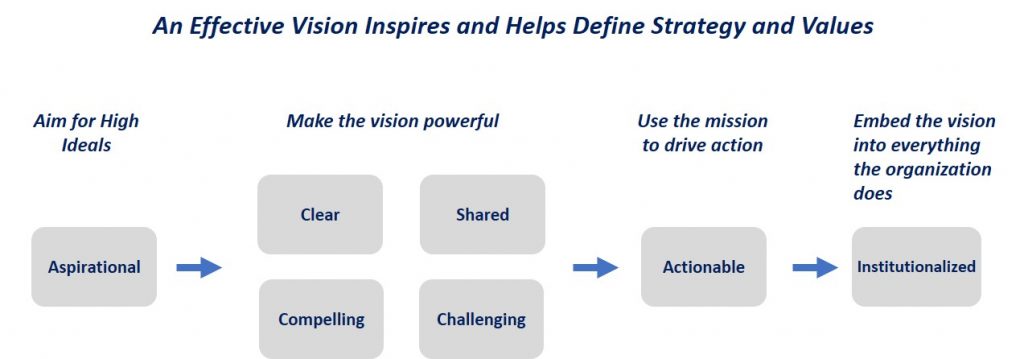 Vision communicates a vivid picture of what an organization should become. By creating a concrete and tangible picture of a desirable near-term future, vision reinforces the commitment to achieve and sharpens the focus generated by the mission.
Vision communicates a vivid picture of what an organization should become. By creating a concrete and tangible picture of a desirable near-term future, vision reinforces the commitment to achieve and sharpens the focus generated by the mission.
An effective vision is a powerful beacon that inspires every member of the organization and counteracts the centrifugal forces of self-interest and cynicism. Vision serves as the criteria for selecting values, the starting point for the formulation of strategy and a guide to day-to-day operational decisions.
Too often managers who view themselves as focused and practical are skeptical about vision. They view it as soft, theoretical, even philosophical, something that gets in the way of important daily work. Already steeped in their organization’s mission, they often believe that the importance of the work is self-evident.
“After all, people are being paid to do their job aren’t they, so why waste time talking about this nebulous, unnecessary thing called vision? It’s awkward to talk about, nobody gets it, and we have ‘real’ issues to deal with,” are the elements of the trap these managers fall into. Once there, they relegate any communication on vision to uninspired, perfunctory statements and move on to the “real” issues as quickly as possible.
This approach has profound negative consequences for an organization. The tools of management become meaningless without the cohesive force of vision. So, the real question becomes: Will vision become an unaccepted and therefore a failed exercise, serving only to reinforce the organization’s status quo or will it rather inspire and draw people into the mission?
In the absence of a clear, leading vision, employees and stakeholders can easily assume that the status quo is the vision. Status quo visions are inexplicit and blurred. This makes it easier, for those so inclined, to rationalize their self-interested action as being consistent with the organization’s good. Status quo visions stifle innovation by looking to the past and obscuring the way forward. They become open to multiple interpretations. This makes it difficult for groups to resolve issues without resorting to higher authorities, leading to confusion, the development of hierarchical structures and eventually micromanagement. In this atmosphere, cynicism takes root, and cynicism is the dangerous solvent that dissolves purpose and promotes fragmentation.
A shared vision is the best antidote to cynicism. In his popular book, The Fifth Discipline, Peter Senge wrote, “When there is a shared vision, people excel and learn, not because they are told to, but because they want to.” (p. 208) Shared vision has the power to transform the ordinary, to provide meaning to daily work, to pull the organization together in pursuit of a common purpose. But it is not enough to create a flashy statement and roll it out through a slick communications campaign. To be effective, it must be genuinely shared by the entire organization.
To be effective, the vision must be an integral force in the daily life of the organization. Vision must guide every aspect of the management of the organization; the values it enforces, the strategy that it adopts, key hiring and resource allocation decisions, and, most importantly, the behavior of the senior leadership team. This can only happen if the organization’s culture, the shared assumptions that orient the actions of every member, become the embodiment of the vision. An effective vision becomes something more than well-articulated statements or the personal project of a leader. It becomes the driving force, the underlying theme, of the organization.
The Pathfinder Performance Model™ identifies seven key attributes of an effective vision. These are the markers we use to evaluate the effectiveness of vision within an organization. To assess the effectiveness of vision within your organization, use the following checklist.
1. Is the vision aspirational? Does the vision describe how the highest ideals of your organization will come to life in the near future?
2. Is the vision clear? Is it easy to communicate? Can it be explained in a short “elevator” speech of less than two minutes?
3. Is the vision compelling? Is it a powerful force in the lives of the members of your organization?
4. Is the vision shared? Does it speak to the most important interests of employees, stakeholders, and customers?
5. Is the vision challenging? Does it stretch the limits of the organization’s current course and speed?
6. Is the vision actionable? Does it help identify specific goals that can be achieved?
7. Is the vision institutionalized? Does the entire organization share and act upon a common vision?

If you can answer yes to these questions, then you can have reasonable assurance that vision is an effective force driving your organization to higher performance. If you answered no to one or more of these questions, then you know where to focus your improvement efforts. The following learning resources for each attribute of an effective vision that may be useful to your efforts. Please post if there are other resources that you think might be useful.
Aspirational
Classic discussions on the power of aspirational vision: Peter M Senge, The Fifth Discipline: The Art and Practice of the Learning Organization; Burt Nanus, Visionary Leadership.
Using vision to drive change: Louis V. Gerstner Jr., Who Says Elephants Can’t Dance: Leading a Great Enterprise Through Dramatic Change.
How to use vision to mobilize support for a public agency: Mark H. Moore, Creating Public Value: Strategic Management in Government, pp. 92–4.
Clear
A classic discussion of the critical importance of communicating vision: John Kotter, Leading Change (See Chapter6: “Communicating the Vision.”)
A discussion of the specific content of vision that creates the most effective communication: Andrew M. Carton, Chad Murphy, and Jonathan R.Clark, “A (Blurry) Vision of The Future: How Leader Rhetoric About Ultimate Goals Influences Performance,” Academy of Management Journal, 2014, Vol. 57, No. 6, pp.1544–1570.
The power of imagery to communicate vision: Emrich, C.G., Brower, H.H., Feldman, J.M.,& Garland, H., 2001. “Images in Words: Presidential Rhetoric, Charisma, and Greatness,” Administrative Science Quarterly, 46: 527–557.
A highly technical psychological study that demonstrates that it is easier to recall imagery than abstract ideas: Kroll, J.F., & Merves, J.S., “Lexical Access for Concrete and Abstract Words,” Journal of Experimental Psychology Learning Memory and Cognition, (1986) 12: 92
Compelling
Make the vision compelling by aligning its vision with cultural and professional values: Edgar H. Schein, Organizational Culture and Leadership.
Shared
How to Build a Shared Vision: John Kotter, Leading Change.
Creating a Shared Vision: James S. Kouzes and Barry Posner, “To Lead, Create a Shared Vision,” The Harvard Business Review, January 2009.
Challenging
The Importance of challenging vision: Sooksan Kantabutra and Gayle C. Avery, “The power of vision: statements that resonate,” Journal of Business Strategy, Vol. 31, No. 1, pp. 37–45.
How audacious goals empower vision: James C. Collins and Jerry I. Porras, “Organizational Vision and Visionary Organizations, California Management Review, 32, Fall 1991.
Actionable
Techniques to align vision and strategy: Robert Kaplan and David P. Norton, The Strategy- Focused Organization, 2004.
Institutionalized
How to make a vision a powerful force in an organization: Douglas A. Ready and Jay A. Conger, “Enabling Bold Visions,” Sloan Management Review, Winter 2008, Vol. 49, No. 2, pp. 70–76.
Dr. Andrew Pavord is a GovLoop Featured Contributor. He is a former government executive who currently is the CEO of the Federal Consulting Alliance. He led budget processes for DC government, SBA, and Treasury, managed department headquarters operations for Treasury, and served as chief of staff to the CFO of the Department of Veterans Affairs. Read his posts here.





Thanks for this detailed, informative post! Lots to think about here.
Thanks for the additional resources. Good reading!